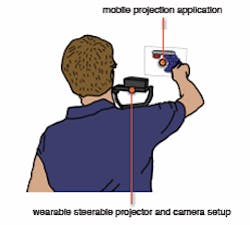Shoulder-mounted projector uses Kinect to track movement
Engineers at the University of Munich (Munich, Germany) have developed a shoulder-mounted system that tracks the movement of users' hands and fingers as they interact with images projected by the system onto a surface.
The so-called Attjector system uses a Microsoft (Redmond, WA, USA) Kinect sensor and an Optoma (Fremont, CA, USA) PK 201 pico projector. The Kinect's depth image is used to track the position of the user's hand, and monitor the scene to determine how the user's fingers are interacting with the display.
Both the Kinect sensor and the Optoma pico projector are seated in a gimbaled mount with three freedoms of rotation. The mount is actively stabilized, enabling it to react quickly to sudden user movements so that the projected image remains stable at all times.To perform the stabilization, the gimbaled mount is equipped with an accelerometer, a gyroscope and three servo motors.
The researchers say that their the prototype system not only relieves a user from the task of controlling a projector, but also gives the user the freedom to interact naturally with the images projected from it.
In the future, they intend to demonstrate how the Attjector system could be used for mobile applications in the areas of augmented environments, navigation and gaming.
University of Munich researchers Sven Kratz, Michael Rohs, Felix Reitberger, and Jörg Moldenhauer presented their research results at the First Workshop on Kinect in Pervasive Computing, which was held in Newcastle, UK, in mid-June.
A copy of their presentation is available here.
Interested in reading how others are using the Kinect? Here's a compendium of ten news stories on the Kinect that Vision Systems Design has published over the past six months.
1. Kinect gets a grip on gait recognition
Researchers at the Ludwig-Maximilians University (Munich, Germany) have built a system using Microsoft's Kinect sensor to identify individuals from their gait.
2. Air marshalling with the Kinect
A senior software developer at Beca Applied Technologies (Auckland, NZ) has used the Kinect sensor from Microsoft (Redmond, WA, USA) and the VBS2 simulation environment from Bohemia Interactive Simulations (Prague, Czech Republic) to explore whether the combination could be used to build a system to train personnel in aircraft marshalling.
3. How accurate is the Kinect?
An assistant professor at the Faculty of Geo-Information Science and Earth Observation of the University of Twente (Enschede, The Netherlands) has written a technical paper that analyses the accuracy and resolution of the depth data from the Microsoft Kinect sensor.
4. Kinect helps stroke victims recover manual agility
Researchers at of Southampton University (Southampton, UK) and Roke Manor Research (Romsey, UK) have used Microsoft's Kinect to develop a biomechanics system that measures hand joint movement that can help stroke patients recover manual agility.
5. Kinect system tracks household objects
Two researchers from the Department of Computer Science at the University of Virginia (Charlottesville, VA, USA) have developed algorithms that can be used with Microsoft Kinect hardware to locate and track household objects.
6. 3-D image reconstruction uses multiple structured-light cameras
Microsoft researchers have developed new software that has enabled them to reconstruct a 3-D scene from multiple structured-light based cameras.
7. 3-D algorithms combine with Kinect to track objects using continuous point cloud data
Ryohei Ueda from the JSK laboratory at the University of Tokyo (Tokyo, Japan) has developed 3-D algorithms that can be used with the Microsoft Kinect to help computer systems track objects in a scene in real time.
8. Satellites dock with Microsoft's Kinect
Engineers at the University of Surrey (Guildford, UK) and Surrey Satellite Technology Limited (SSTL; Guildford, UK) are developing an in-orbit docking system for small satellites that is based upon Microsoft’s Kinect system.
9. Microsoft’s Kinect helps keep surgery sterile
Engineers based at Microsoft Research (Cambridge, UK) have developed a system based on the Microsoft Kinect that allows surgeons to manipulate images in the operating theater.
10. Shoppers create 3-D models of their own bodies online
A startup company established by a team that includes several alumni from the University of Cambridge’s Department of Engineering (Cambridge, UK) has developed technology intended to help shoppers buy clothes online.
-- Dave Wilson, Senior Editor, Vision Systems Design
